Thermodynamic Performance Comparisons of Ideal Brayton Cycles Integrated with High Temperature Fuel Cells as Power Sources on Aircraft
Abstract
1. Introduction
2. SOFC Brayton Cycles
3. Methodology
3.1. Model Assumptions
- (1)
- The working fluids are air, which is considered to be the ideal gas;
- (2)
- The fuel is assumed as hydrogen, and the reforming process is neglected. It can be directly used by the SOFC without being reformed;
- (3)
- The total pressure recovery coefficient of the fuel cells is 1;
- (4)
- The combustion efficiency is 1;
- (5)
- The expansion and compression components are assumed as isentropic;
- (6)
- The mass flow rate of the working fluids is assumed to be constant;
- (7)
- The mass flow rate of the fuel is negligible;
- (8)
- The energy of preheating and compressing the fuel is neglected.
3.2. Fuel Cells
3.3. Ideal Brayton Cycles with the SOFC
4. Results and Discussion
4.1. Pressure Ratio
4.2. Combustion Temperature
4.3. Reheat Pressure Ratio
5. Conclusions
- (1)
- The thermal efficiency and specific thrust of the ideal BFC both increase with the increase of the pressure ratio. However, there is a maximum pressure ratio of 32.4 due to the limitation of the temperature difference between the fuel cell inlet and the outlet. The highest thermal efficiency of the BFC is 73.2% at a pressure ratio of 32.4. The highest thermal efficiency of the BC is 63.0% at a pressure ratio of 60. The BFC has an obvious advantage over the BC and the RBC in thermal efficiency.
- (2)
- The thermal efficiency of the BFC decreases as the combustion temperature increases. The thermal efficiencies of the RBFC and IBFC show the opposite trends. The maximum thermal efficiency of the BFC at the lowest combustion temperature is 82.2%, while that of the BC is 65.1%.
- (3)
- The thermal efficiency of the RBFC and the IBFC decreases with an increase in the reheat pressure ratio. The specific thrust increases slowly and then decreases sharply in the RBFC. The specific thrust of the IBFC increases with the increase of the reheat pressure ratios. The maximum specific thrust of the IBFC is 2058 N/(kg∙s−1).
- (4)
- Even though the application of the innovative power cycle composed of fuel cells and gas turbines on aircraft is challenging, it provides a new prospect for the development of low-emission aircraft. The electricity aircraft will save fossil fuel and produce little carbon dioxide emission largely.
Supplementary Materials
Author Contributions
Funding
Institutional Review Board Statement
Informed Consent Statement
Data Availability Statement
Conflicts of Interest
Nomenclature
| A | Area (m2) | Subscripts | |
| c | Velocity (m/s) | a | Air |
| cp | Constant-pressure specific heat (J/(kg.K)/s) | abs | Heat addition |
| F | Faraday constant (96,485 C/mol) | comp | Compressor |
| FS | Specific thrust (N/(kg/s)) | fc | Fuel cell |
| G | Gibbs free energy (J/mol/s) | g | Exhaust |
| H | Enthalpy (J/mol/s) | max | Maximum |
| I | Current (A) | out | Open circuit voltage |
| n | Mole rate of electrons | out | Outlet |
| p | Pressure (Pa) | BC | Brayton cycle |
| P | Power (J/s) | BFC | Brayton cycle with SOFC |
| Q | The amount of heat (J/s) | IBFC | Isothermal Brayton cycle with SOFC |
| Rfc | Ratio of fuel cell power and heat | RBC | Reheating Brayton cycle |
| T | Temperature (K) | RBFC | Reheated Brayton cycle with SOFCs |
| U | Voltage (V) | PEMFC | Proton exchange membrane fuel cell |
| Mass flow (kg/s) | SOFC | Solid oxide fuel cell | |
| Temperature difference between SOFC inlet and outlet | |||
| Ratio of electric power and total power | Superscript | ||
| Temperature ratio | 0 | Ideal conditions | |
| ϕ | Fuel utilization | ||
| Pressure ratio | |||
| Ratio of specific heat | |||
| Thermal efficiency |
References
- Roth, B.; Giffin, R. Fuel cell hybrid propulsion challenges and opportunities for commercial aviation. In Proceedings of the 46th AIAA/ASME/SAE/ASEE Joint Propulsion Conference & Exhibit, Nashville, TN, USA, 25–28 July 2010; p. 6537. [Google Scholar]
- Rutledge, J.L.; Polanka, M.D. Efficiency of an Ideal Brayton Cycle with a Constant-Volume Interturbine Burner. J. Propuls. Power 2015, 31, 970–976. [Google Scholar] [CrossRef]
- Sarmah, P.; Gogoi, T.K.; Das, R. Estimation of operating parameters of a SOFC integrated combined power cycle using differential evolution based inverse method. Appl. Therm. Eng. 2017, 119, 98–107. [Google Scholar] [CrossRef]
- Hwang, S.-J.; Kim, S.-G.; Kim, C.-W.; Lee, Y.-G. Aerodynamic Design of the Solar-Powered High Altitude Long Endurance (HALE) Unmanned Aerial Vehicle (UAV). Int. J. Aeronaut. Space Sci. 2016, 17, 132–138. [Google Scholar] [CrossRef]
- Stoia, T.; Atreya, S.; O’Neil, P. A Highly Efficient Solid Oxide Fuel Cell Power System for an All-Electric Commuter Airplane Flight Demonstrator. In Proceedings of the 54th AIAA Aerospace Sciences Meeting, San Diego, CA, USA, 4–8 January 2016; p. 1024. [Google Scholar]
- Borer, N.K.; Geuther, S.C.; Litherland, B.L.; Kohlman, L.W. Design and Performance of a Hybrid-Electric Fuel Cell Flight Demonstration Concept. In Proceedings of the Aviation Technology, Integration, and Operations Conference, Atlanta, GA, USA, 25–29 June 2018; p. 3357. [Google Scholar]
- Fernandes, M.D.; Andrade, S.T.d.P.; Bistritzki, V.N.; Fonseca, R.M.; Zacarias, L.G.; Goncalves, H.N.C.; de Castro, A.F.; Domingues, R.Z.; Matencio, T. SOFC-APU systems for aircraft: A review. Int. J. Hydrogen Energy 2018, 43, 16311–16333. [Google Scholar] [CrossRef]
- Lapeña-Rey, N.; Mosquera, J.; Bataller, E.; Ortí, F. First fuel-cell manned aircraft. J. Aircr. 2010, 47, 1825–1835. [Google Scholar] [CrossRef]
- Correa, G.; Santarelli, M.; Borello, F.; Cestino, E.; Romeo, G. Flight test validation of the dynamic model of a fuel cell system for ultra-light aircraft. Proc. Inst. Mech. Eng. Part G J. Aerosp. Eng. 2015, 229, 917–932. [Google Scholar] [CrossRef]
- Bégot, S.; Harel, F.; Candusso, D.; François, X.; Péra, M.-C.; Yde-Andersen, S. Fuel cell climatic tests designed for new configured aircraft application. Energy Convers. Manag. 2010, 51, 1522–1535. [Google Scholar] [CrossRef]
- Renau, J.; Barroso, J.; Lozano, A.; Nueno, A.; Sánchez, F.; Martín, J.; Barreras, F. Design and manufacture of a high-temperature PEMFC and its cooling system to power a lightweight UAV for a high altitude mission. Int. J. Hydrogen Energy 2016, 41, 19702–19712. [Google Scholar] [CrossRef]
- Lapeña-Rey, N.; Blanco, J.; Ferreyra, E.; Lemus, J.; Pereira, S.; Serrot, E. A fuel cell powered unmanned aerial vehicle for low altitude surveillance missions. Int. J. Hydrogen Energy 2017, 42, 6926–6940. [Google Scholar] [CrossRef]
- Kim, T. NaBH4 (sodium borohydride) hydrogen generator with a volume-exchange fuel tank for small unmanned aerial vehicles powered by a PEM (proton exchange membrane) fuel cell. Energy 2014, 69, 721–727. [Google Scholar] [CrossRef]
- Baldic, J.; Osenar, P.; Lauder, N.; Launie, P. Fuel cell systems for long duration electric UAVs and UGVs. In Proceedings of the Defense Transformation and Net-Centric Systems 2010, Orlando, FL, USA, 6–8 April 2010; Volume 7707, p. 770703. [Google Scholar]
- González-Espasandín, Ó.; Leo, T.J.; Raso, M.A.; Navarro, E. Direct methanol fuel cell (DMFC) and H2 proton exchange membrane fuel (PEMFC/H2) cell performance under atmospheric flight conditions of Unmanned Aerial Vehicles. Renew. Energy 2019, 130, 762–773. [Google Scholar] [CrossRef]
- Marchant, W.; Tosunoglu, S. Rethinking Wildfire Suppression With Swarm Robotics. In Proceedings of the 29th Florida Conference on Recent Advances in Robotics. 2016. Available online: https://www.semanticscholar.org/paper/Rethinking-Wildfire-Suppression-With-Swarm-Robotics-Marchant-Tosunoglu/8c4d7e9a524592c1f0d83fcd9868241454d72290 (accessed on 8 November 2022).
- Giacoppo, G.; Barbera, O.; Briguglio, N.; Cipitì, F.; Ferraro, M.; Brunaccini, G.; Erdle, E.; Antonucci, V. Thermal study of a SOFC system integration in a fuselage of a hybrid electric mini UAV. Int. J. Hydrogen Energy 2017, 42, 28022–28033. [Google Scholar] [CrossRef]
- Chu, D.; Jiang, R.; Dunbar, Z.; Grew, K.; McClure, J. Fuel cell powered small unmanned aerial systems (UASs) for extended endurance flights. In Proceedings of the Unmanned Systems Technology XVII, Baltimore, MD, USA, 21–23 April 2015; Volume 9468, p. 94680E. [Google Scholar]
- Ding, X.; Lv, X.; Weng, Y. Coupling effect of operating parameters on performance of a biogas-fueled solid oxide fuel cell/gas turbine hybrid system. Appl. Energy 2019, 254, 113675. [Google Scholar] [CrossRef]
- Choi, W.; Kim, J.; Kim, Y.; Kim, S.; Oh, S.; Song, H.H. Experimental study of homogeneous charge compression ignition engine operation fuelled by emulated solid oxide fuel cell anode off-gas. Appl. Energy 2018, 229, 42–62. [Google Scholar] [CrossRef]
- Hosseinpour, J.; Sadeghi, M.; Chitsaz, A.; Ranjbar, F.; Rosen, M.A. Exergy assessment and optimization of a cogeneration system based on a solid oxide fuel cell integrated with a Stirling engine. Energy Convers. Manag. 2017, 143, 448–458. [Google Scholar] [CrossRef]
- Himansu, A.; Freeh, J.E.; Steffen Jr, C.J.; Tornabene, R.T.; Wang, X.-Y.J. Hybrid solid oxide fuel cell/gas turbine system design for high altitude long endurance aerospace missions. In Proceedings of the International Conference on Fuel Cell Science, Engineering and Technology, Irvine, CA, USA, 19–21 June 2006; Volume 42479, pp. 573–583. [Google Scholar]
- Aguiar, P.; Brett, D.; Brandon, N. Solid oxide fuel cell/gas turbine hybrid system analysis for high-altitude long-endurance unmanned aerial vehicles. Int. J. Hydrogen Energy 2008, 33, 7214–7223. [Google Scholar] [CrossRef]
- Waters, D.F.; Cadou, C.P. Engine-integrated solid oxide fuel cells for efficient electrical power generation on aircraft. J. Power Sources 2015, 284, 588–605. [Google Scholar] [CrossRef]
- Yanovskiy, L.S.; Baykov, A.; Raznoschikov, V.; Averkov, I. Alternative Fuels and Perspectives Solid Oxide Fuel Cells Usage in Air Transport. ECS Trans. 2013, 57, 149–160. [Google Scholar] [CrossRef]
- Okai, K.; Nomura, H.; Tagashira, T.; Nishizawa, A. Effects of Fuel Type on Aircraft Electric Propulsion with SOFC/GT Hybrid Core. In Proceedings of the AIAA/SAE/ASEE Joint Propulsion Conference, Atlanta, GA, USA, 10–12 July 2017. [Google Scholar]
- Ji, Z.; Qin, J.; Cheng, K.; Liu, H.; Zhang, S.; Dong, P. Thermodynamic analysis of a solid oxide fuel cell jet hybrid engine for long-endurance unmanned air vehicles. Energy Convers. Manag. 2019, 183, 50–64. [Google Scholar] [CrossRef]
- Sirignano, W.A.; Dunn-Rankin, D.; Liu, F.; Colcord, B.; Puranam, S.J.A.J. Turbine Burners: Performance Improvement and Challenge of Flameholding. AIAA J. 2015, 50, 1645–1669. [Google Scholar] [CrossRef]
- Haseli, Y. Maximum conversion efficiency of hydrogen fuel cells. Int. J. Hydrogen Energy 2018, 43, 9015–9021. [Google Scholar] [CrossRef]
- Ji, Z.; Rokni, M.M.; Qin, J.; Zhang, S.; Dong, P. Performance and size optimization of the turbine-less engine integrated solid oxide fuel cells on unmanned aerial vehicles with long endurance. Appl. Energy 2021, 299, 117301. [Google Scholar] [CrossRef]
- Ji, Z.; Qin, J.; Cheng, K.; Dang, C.; Zhang, S.; Dong, P. Thermodynamic performance evaluation of a turbine-less jet engine integrated with solid oxide fuel cells for unmanned aerial vehicles. Appl. Therm. Eng. 2019, 160, 114093. [Google Scholar] [CrossRef]
- Liu, F.; Sirignano, W.A. Turbojet and turbofan engine performance increases through turbine burners. J. Propuls. Power 2001, 17, 695–705. [Google Scholar] [CrossRef]
- Thacker, B.H.; Doebling, S.W.; Hemez, F.M.; Anderson, M.C.; Pepin, J.E.; Rodriguez, E.A. Concepts of model verification and validation. Los Alamos Natl. Lab 2002. [Google Scholar] [CrossRef]
- Aguiar, P.; Adjiman, C.S.; Brandon, N.P. Anode-supported intermediate temperature direct internal reforming solid oxide fuel cell. I: Model-based steady-state performance. J. Power Sources 2004, 138, 120–136. [Google Scholar] [CrossRef]
- American Institute of Aeronautics and Astronautics. AIAA Guide for the Verification and Validation of Computational Fluid Dynamics Simulations; American Institute of Aeronautics and Astronautics: Reston, VA, USA, 1998. [Google Scholar]
- Suwanwarangkul, R.; Croiset, E.; Entchev, E.; Charojrochkul, S.; Pritzker, M.D.; Fowler, M.W.; Mahaudom, H. Experimental and modeling study of solid oxide fuel cell operating with syngas fuel. J. Power Sources 2006, 161, 308–322. [Google Scholar] [CrossRef]

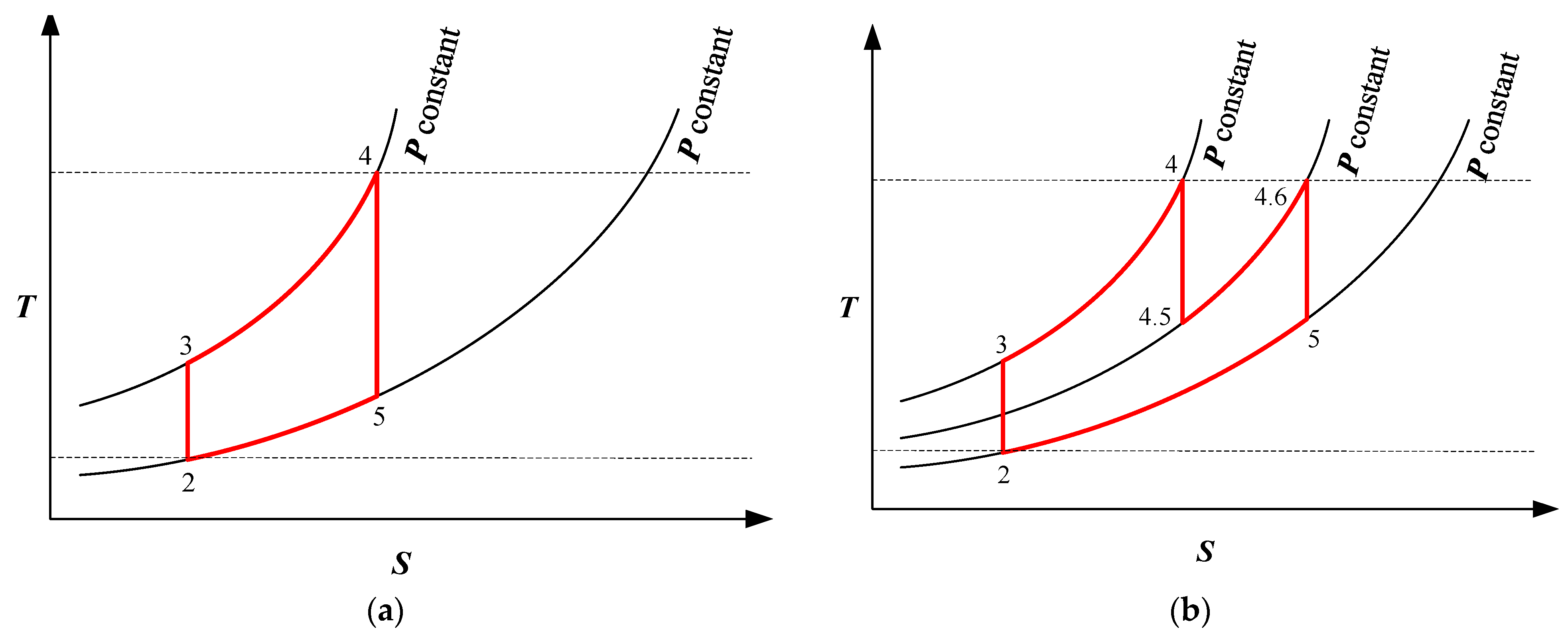

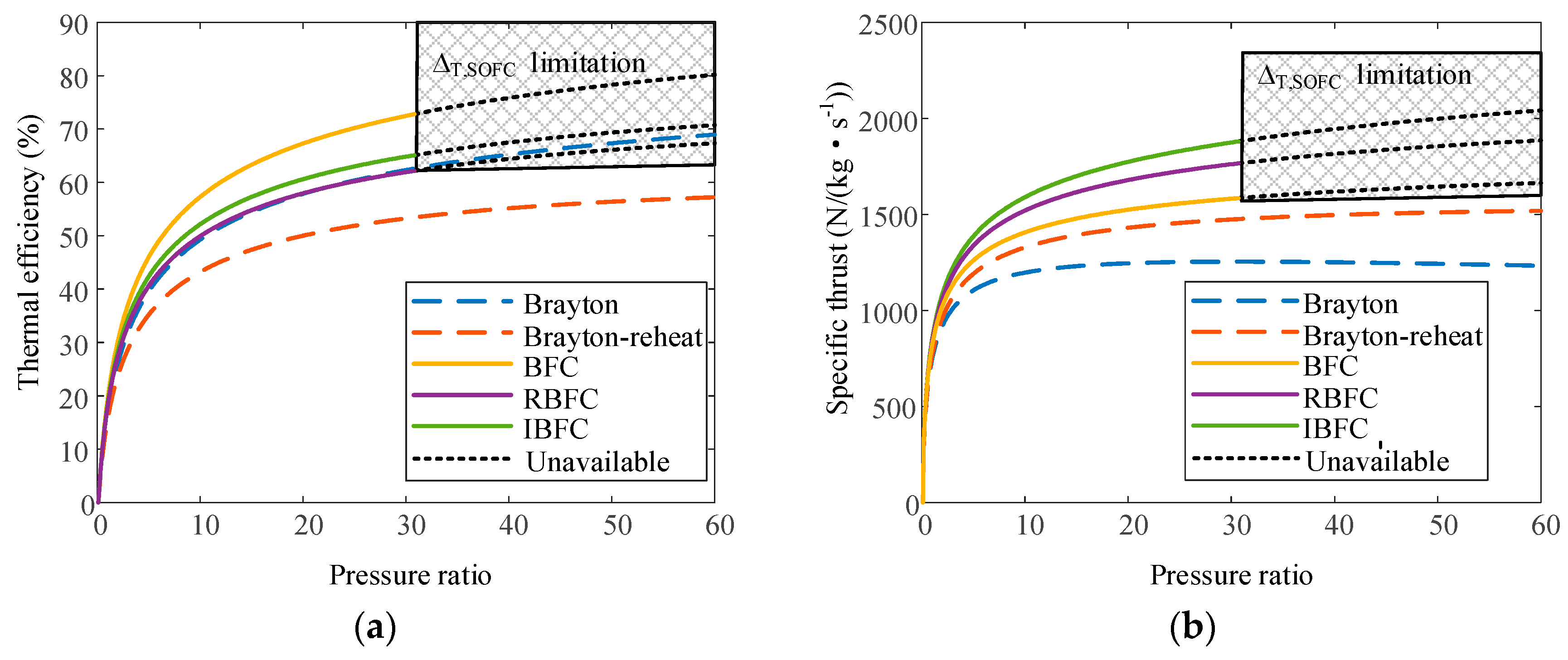
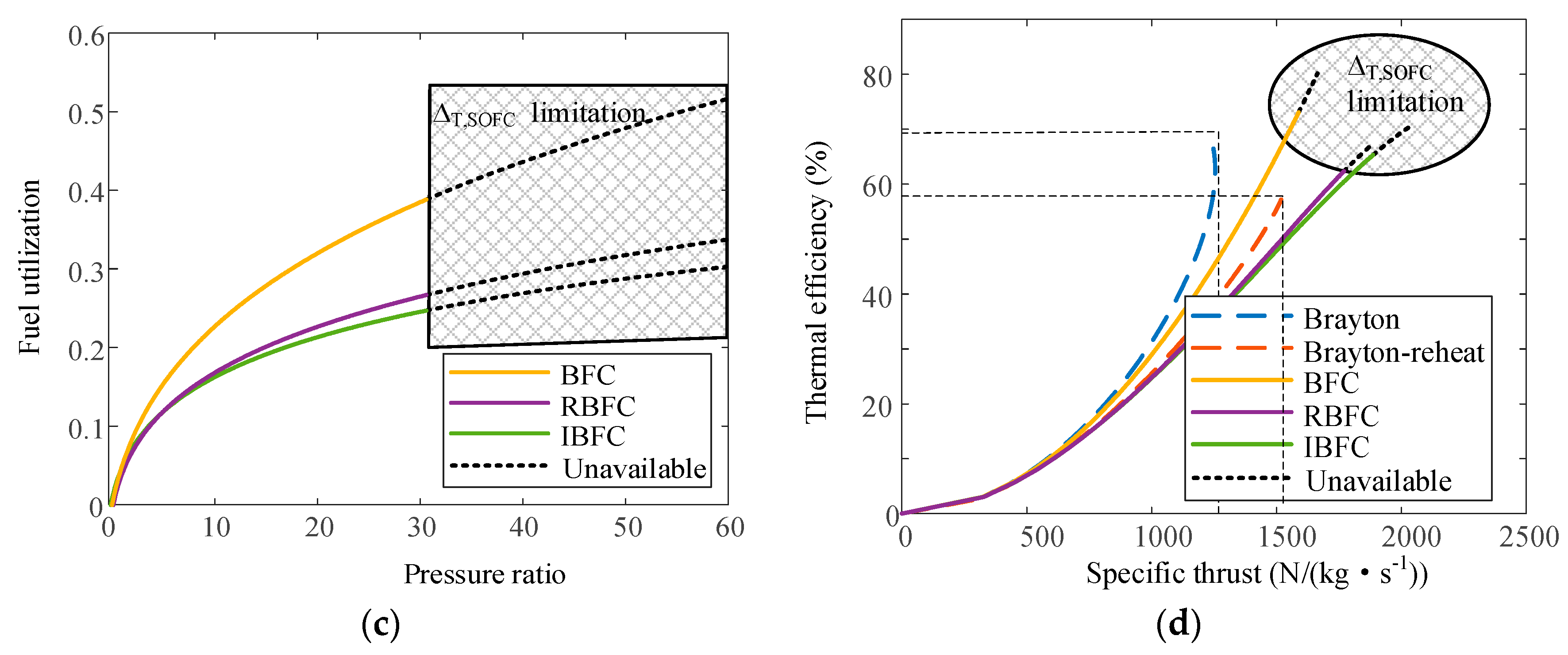
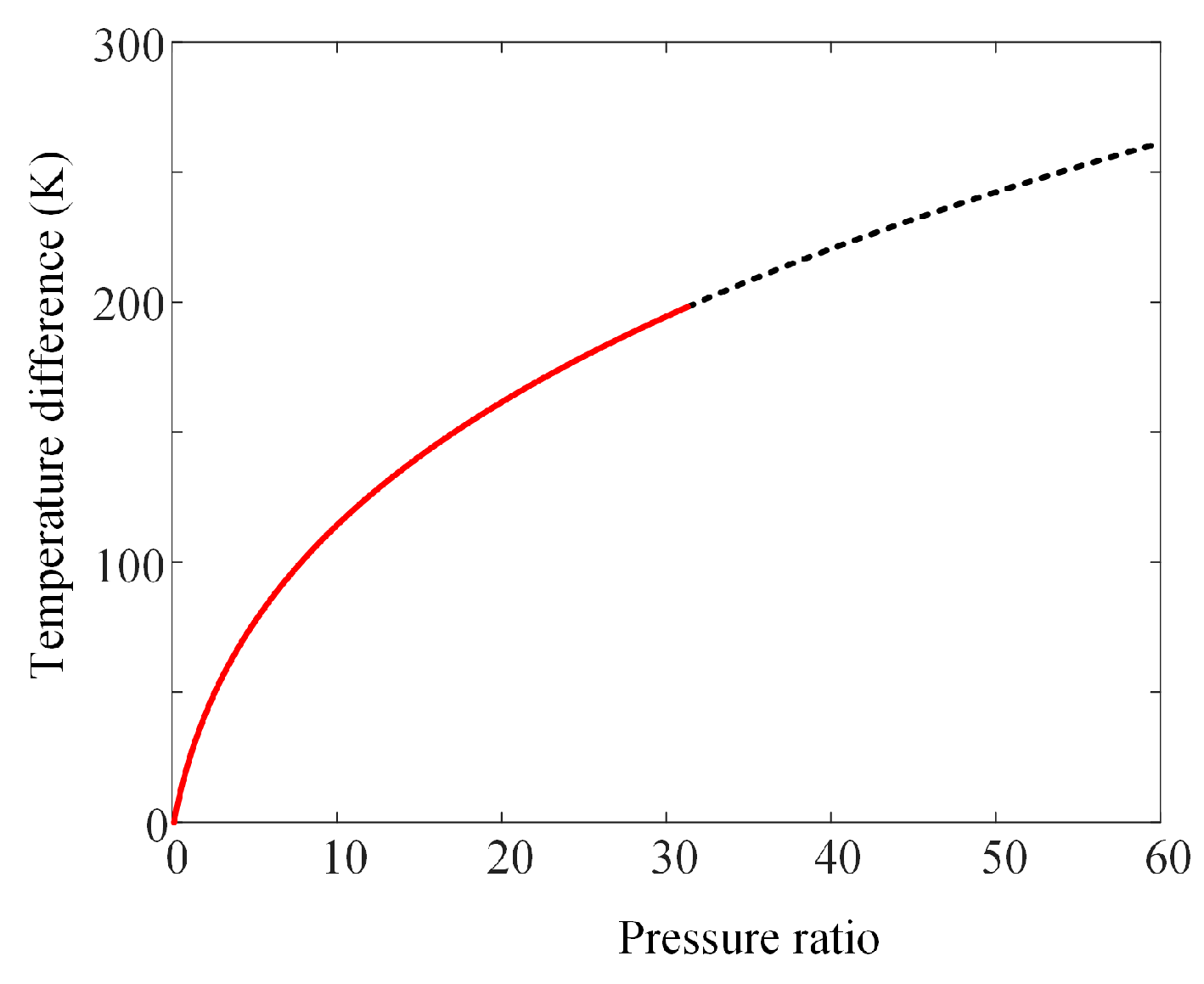
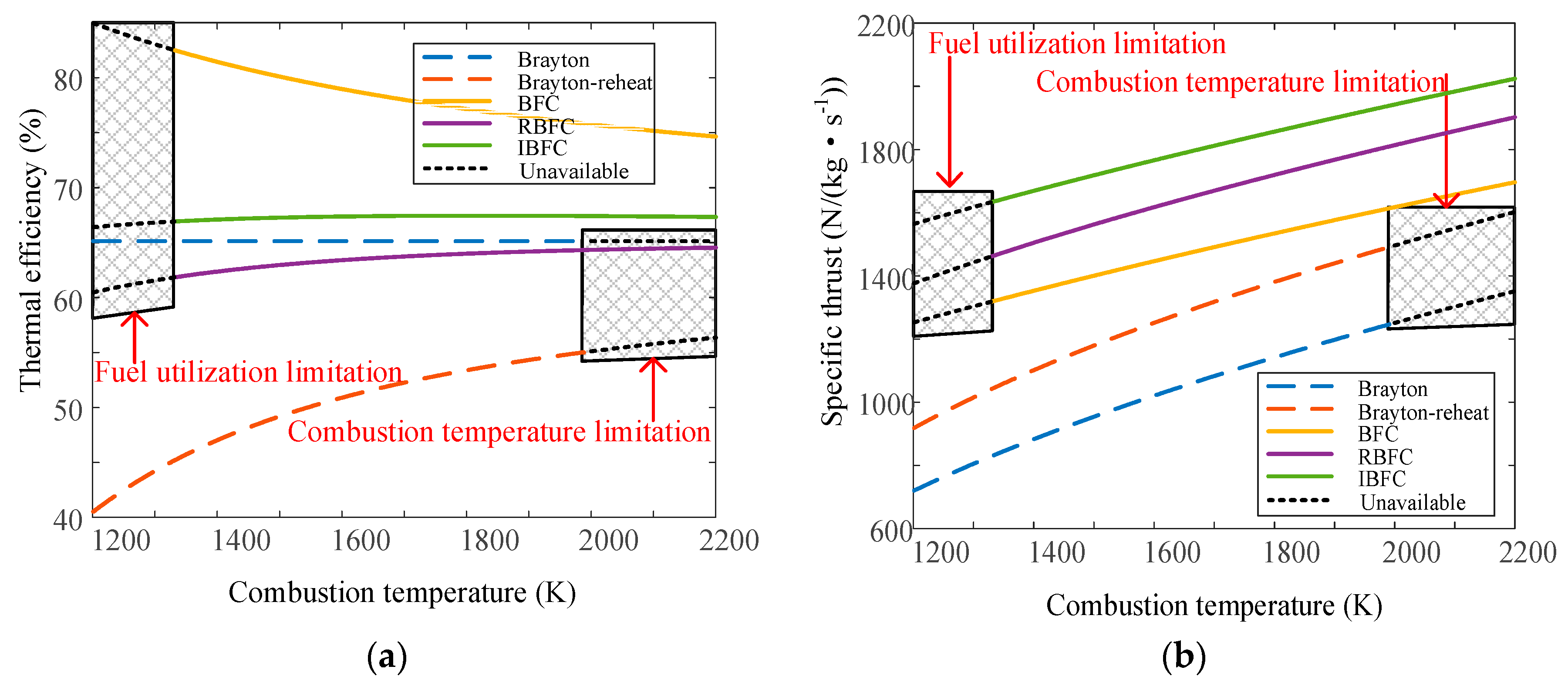
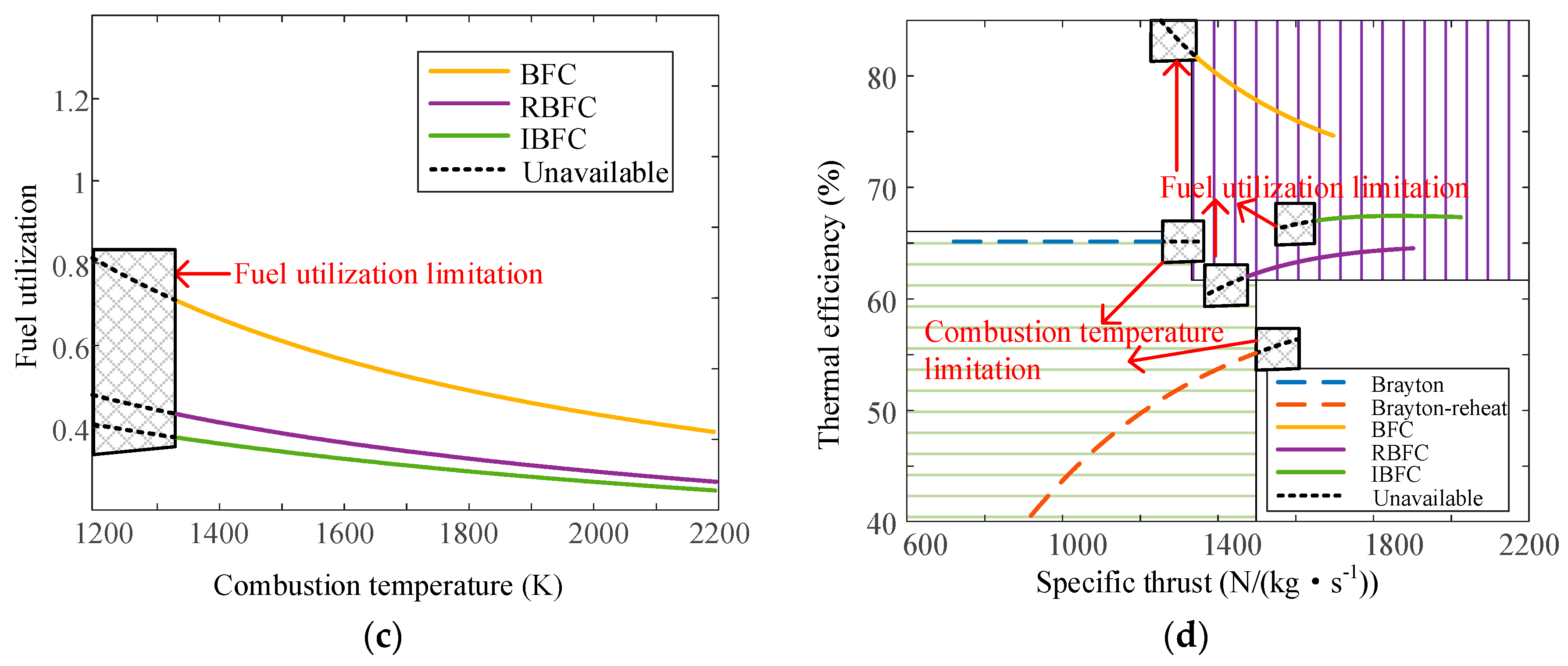

| Items | The Study | Previous Study |
|---|---|---|
| Cycle | Ideal | Practical |
| Research method | Equation derivation | Detailed thermodynamic model |
| Research content | Fundamental thermodynamic parameters | Complex system performance |
Disclaimer/Publisher’s Note: The statements, opinions and data contained in all publications are solely those of the individual author(s) and contributor(s) and not of MDPI and/or the editor(s). MDPI and/or the editor(s) disclaim responsibility for any injury to people or property resulting from any ideas, methods, instructions or products referred to in the content. |
© 2023 by the authors. Licensee MDPI, Basel, Switzerland. This article is an open access article distributed under the terms and conditions of the Creative Commons Attribution (CC BY) license (https://creativecommons.org/licenses/by/4.0/).
Share and Cite
Ji, Z.; Guo, F.; Zhu, T.; Cheng, K.; Zhang, S.; Qin, J.; Dong, P. Thermodynamic Performance Comparisons of Ideal Brayton Cycles Integrated with High Temperature Fuel Cells as Power Sources on Aircraft. Sustainability 2023, 15, 2805. https://doi.org/10.3390/su15032805
Ji Z, Guo F, Zhu T, Cheng K, Zhang S, Qin J, Dong P. Thermodynamic Performance Comparisons of Ideal Brayton Cycles Integrated with High Temperature Fuel Cells as Power Sources on Aircraft. Sustainability. 2023; 15(3):2805. https://doi.org/10.3390/su15032805
Chicago/Turabian StyleJi, Zhixing, Fafu Guo, Tingting Zhu, Kunlin Cheng, Silong Zhang, Jiang Qin, and Peng Dong. 2023. "Thermodynamic Performance Comparisons of Ideal Brayton Cycles Integrated with High Temperature Fuel Cells as Power Sources on Aircraft" Sustainability 15, no. 3: 2805. https://doi.org/10.3390/su15032805
APA StyleJi, Z., Guo, F., Zhu, T., Cheng, K., Zhang, S., Qin, J., & Dong, P. (2023). Thermodynamic Performance Comparisons of Ideal Brayton Cycles Integrated with High Temperature Fuel Cells as Power Sources on Aircraft. Sustainability, 15(3), 2805. https://doi.org/10.3390/su15032805








